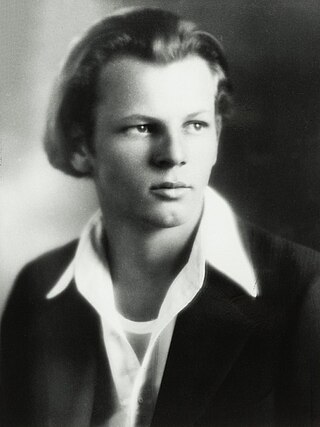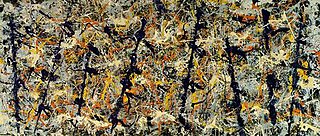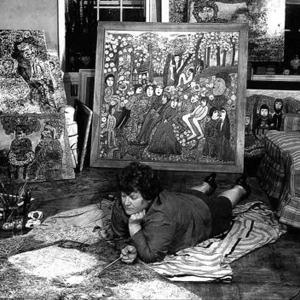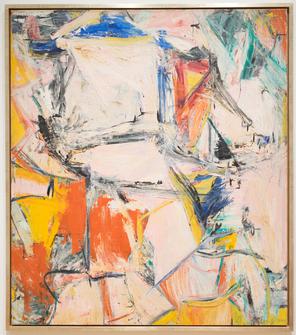
Paul Jackson Pollock was an American painter. A major figure in the abstract expressionist movement, Pollock was widely noticed for his "drip technique" of pouring or splashing liquid household paint onto a horizontal surface, enabling him to view and paint his canvases from all angles. It was called all-over painting and action painting, since he covered the entire canvas and used the force of his whole body to paint, often in a frenetic dancing style. This extreme form of abstraction divided the critics: some praised the immediacy of the creation, while others derided the random effects. In 2016, Pollock's painting titled Number 17A was reported to have fetched US$200 million in a private purchase.
Abstract expressionism was first used in Germany in 1919 in the magazine Der Sturm, regarding German Expressionism. Alfred Barr was the first to use this term in 1929 for works by Wassily Kandinsky.

Willem de Kooning was a Dutch-American abstract expressionist artist. He was born in Rotterdam and moved to the United States in 1926, becoming an American citizen in 1962. In 1943, he married painter Elaine Fried.

Lenore "Lee" Krasner was an American Abstract Expressionist painter and visual artist active primarily in New York. She received her early academic training at the Women's Art School of Cooper Union, and the National Academy of Design from 1928 to 1932. Krasner's exposure to Post-Impressionism at the newly opened Museum of Modern Art in 1929 led to a sustained interest in modern art. In 1937, she enrolled in classes taught by Hans Hofmann, which led her to integrate influences of Cubism into her paintings. During the Great Depression, Krasner joined the Works Progress Administration's Federal Art Project, transitioning to war propaganda artworks during the War Services era.

Color field painting is a style of abstract painting that emerged in New York City during the 1940s and 1950s. It was inspired by European modernism and closely related to abstract expressionism, while many of its notable early proponents were among the pioneering abstract expressionists. Color field is characterized primarily by large fields of flat, solid color spread across or stained into the canvas creating areas of unbroken surface and a flat picture plane. The movement places less emphasis on gesture, brushstrokes and action in favor of an overall consistency of form and process. In color field painting "color is freed from objective context and becomes the subject in itself."

Joseph Wiltsie Fuller Potter Jr. was an American Abstract expressionist artist. He was born in New York City in 1910, attended St. Bernard's School in New York and Groton School in Groton, Massachusetts, and lived most of his life in his Ledyard, Connecticut estate, near Old Mystic. Potter started painting in the traditional modes of representation, specializing in still life and landscape. His work was shown in New York in the 1930s at the Marie Harriman Gallery.

James David Brooks was an American Abstract Expressionist, muralist, abstract painter, art teacher, and winner of the Logan Medal of the Arts.

Blue Poles, also known as Number 11, 1952 is an abstract expressionist painting by American artist Jackson Pollock. It was purchased amid controversy by the National Gallery of Australia in 1973 and today remains one of the gallery's major paintings.

No. 5, 1948 is a 1948 painting by Jackson Pollock, an American painter known for his contributions to the abstract expressionist movement. It was sold on 22 May 2006 for $140 million, a new mark for highest ever price for a painting, not surpassed until April 2011.
Charles Cecil Pollock was an American abstract painter and the eldest brother of artist Jackson Pollock.

Who the #$&% Is Jackson Pollock? is a 2006 documentary following Teri Horton, a 73-year-old former long-haul truck driver from California, who purchased a painting from a thrift shop for $5, only to find out later that it may be a Jackson Pollock painting. She had no clue at the time who Jackson Pollock was, hence the name of the film.
Drip painting is a form of abstract art in which paint is dripped or poured on to the canvas. This style of action painting was experimented with in the first half of the twentieth century by such artists as Francis Picabia, André Masson and Max Ernst, who employed drip painting in his works The Bewildered Planet, and Young Man Intrigued by the Flight of a Non-Euclidean Fly (1942). Ernst used the novel means of painting Lissajous figures by swinging a punctured bucket of paint over a horizontal canvas.

Janet Sobel, born Jennie Olechovsky, was a Ukrainian-born American Abstract Expressionist painter whose career started mid-life, at age forty-five in 1938. Sobel pioneered the drip painting technique that directly influenced Jackson Pollock. She was credited as exhibiting the first instance of all-over painting seen by Clement Greenberg, a notable art critic.

Autumn Rhythm is a 1950 abstract expressionist painting by American artist Jackson Pollock in the collection of the Metropolitan Museum of Art in New York City. The work is a distinguished example of Pollock's 1947-52 poured-painting style, and is often considered one of his most notable works.

Mural on Indian Red Ground is a 1950 abstract expressionist drip painting by American artist Jackson Pollock, currently in the collection of the Tehran Museum of Contemporary Art. It is valued at about $250 million and is considered one of Pollock's greatest works.

Interchange, also known as Interchanged, is an 1955 abstract expressionist oil painting on canvas by Dutch-American painter Willem de Kooning (1904–1997). Like Jackson Pollock, de Kooning was one of the early artists of the abstract expressionism movement, the first American modern art movement. The painting measures 200.7 by 175.3 centimetres and was completed in 1955. It marked the transition of the subjects of de Kooning's paintings from women to abstract urban landscapes. It reflects a transition in de Kooning's painting technique due the influence of artist Franz Kline, who inspired de Kooning to paint with quickly made gestural marks as opposed to violent brush strokes. The painting features a fleshy pink mass at its center, representing a seated woman.
Harry Andrew Jackson, born Harry Aaron Shapiro Jr., was an American artist. He began his career as a Marine combat artist, then later worked in the abstract expressionist, realist, and American western styles.
Fractal expressionism is used to distinguish fractal art generated directly by artists from fractal art generated using mathematics and/or computers. Fractals are patterns that repeat at increasingly fine scales and are prevalent in natural scenery. Fractal expressionism implies a direct expression of nature's patterns in an art work.

Mural is a 1943 large painting by American artist Jackson Pollock. Although signed and dated 1943, the signature and date were not added until 1947, and the work was probably completed around the fall of 1943. It was made with oil paint on linen, and is Pollock's largest canvas, measuring 2.43 by 6.04 metres. The work was commissioned by Peggy Guggenheim for the long entrance hall of her townhouse at 155 East 61st Street in New York City.
One: Number 31, 1950 is a painting by American painter Jackson Pollock, from 1950. It is one of the largest and most prominent examples of the artists Abstract Expressionist drip-style works. The work was owned by a private collector until 1968 when it was purchased by the Museum of Modern Art, in New York, where it has has been displayed since then.














